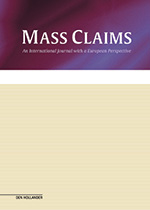German Experience: Court Cases as a Stepping Stone for Legislation
Dr Fabian Reuschle1 Het artikel is in de opmaak van het tijdschrift rechts als pdf beschikbaar.Foreword
In Germany we have many mass claims. In recent years there has been a growing interest in civil procedure rules for cases of mass torts in Germany. To understand the need and the development of collective redress system in Germany, it's worth to look at three mass torts cases in Germany's history and analyze their legal consequences.
Firstly, in the late 1950s and early 1960s, around 5,000 children in Germany and many more worldwide were born with deformities as a consequence of thalidomide use. The criminal case against nine senior employees of Chemie-Grünenthal, the company that created and marketed thalidomide (sold in Germany under the brand name Contergan), involved 400 co-plaintiffs and is still considered as one of the most complex trials in German legal history. The legal and medical questions raised by the thalidomide tragedy were complex and difficult. In the end, the foreseeability of the teratogenic effects of thalidomide were dismissed by experts, leading to the dismissal of many claims. Even though a common assessment could have been possible, the lack of an effective collective redress mechanism resulted in highly inefficient and unsatisfying proceedings.
Secondly, in 1996, the previously state-owned telecoms operator Deutsche Telekom AG went public in Germany for the first time, followed by second and third public offerings in 1999 and 2000. In its prospectus issued at the initial public offering, the company had valued its real estate holdings en bloc rather than on an individual basis. In 2001, these valuations proved to be grossly overstated and Deutsche Telekom was forced to announce the write-down of its real estate portfolio by EUR 2.7 billion. As a result, the value of the stock plummeted. The response of shareholders was overwhelming. Between 2001 and 2003 alone, over 13,000 individual claims against Deutsche Telekom involving 754 different attorneys and alleging misrepresentation were filed with the Regional Court Frankfurt am Main. At the beginning of the Telekom case, German procedural law had no effective collective litigation instrument. In response to complaints about delayed processing due to the sheer number of individual claims, in 2005, the German legislature stepped in and enacted the Capital Markets Model Case Act (KapMuG). This act offers an effective mechanism to the collective litigation of securities claims. After more than 20 years of litigation before the Frankfurt Court of Appeals and two journeys to the Federal Court of Justice (Bundesgerichtshof), a settlement offer by Deutsche Telekom brought Germany's very first and most mature collective model proceedings to an end. The terms of the offer, which Telekom will serve each of the 17,000 plaintiffs by the end of June 2022, are indeed attractive:
- Investors will receive back the initial primary market purchase price of EUR 66.50 per share, minus individual (partial) sales, dividends received, and today's share price (which will be calculated at EUR 16.50 per share).
- In addition, plaintiffs will receive 70% of the interest accumulated over the course of the 20 years of litigation.
- Plaintiffs' court fees and attorney's fees will predominantly be borne by Deutsche Telekom.
Thirdly, the Volkswagen (VW) diesel emissions scandal started in September 2015, when the company admitted that it had installed software in millions of cars globally that allowed vehicles to perform better in test conditions than they did on the road. Making use of the Capital Markets Model Case Act (KapMuG), VW shareholders brought claims against the company for compensation for the decline in share prices caused by the scandal, while shareholders of Porsche SE (which holds a 30.8 percent stake in VW and 52 percent of voting rights) claimed that they too experienced losses because the company failed to disclose in a timely manner the risks it faced by installing the software. In addition to claims by shareholders, there was a flood of claims by diesel car owners against car manufacturers. Again, the Germany legislator noticed the needs in the market. In response to all initiated claims, the German legislator passed a new Model Declaratory Actions Act on November 1, 2018. This instrument, too, was developed in order to litigate mass torts more efficiently and facilitate collective redress for consumers in Germany. In 2021 the German 'Verbraucherzentrale' reached a settlement for up to 260,000 VW customers with a total settlement sum of up to EUR 830 million.
All three cases show that mass claims in the field of, for example, medication, securities disclosure violations and consumer product defects, cannot be adequately addressed by the courts without special litigation procedures. The cases also show that mass claims have a direct effect on legislation. Instead of legislation paving the way for claims, mass claims tend to serve as a stepping stone for legislation. And I don't think that is particularly unique for Germany. Indeed, you see a similar movement in European legislation. Cases tend to become bigger and they cross the borders. In fact, mass claims in Europe are undeniable. As a result, the EU Directive on representative actions for the protection of collective interests of consumers got introduced, setting out minimum standards for procedural rules in Member States for collective redress and injunctions for consumers. This will further shape the German and European landscape for collective redress. For me, as a judge dealing with collective redress cases, I welcome any of such initiatives. But even though many helpful changes have been set in motion, we need to stay alert and be informed of European developments. Only then we can keep steering the legislation in the right direction and enable justice where needed. The Mass Claims Journal provides me with insights that are so needed in this emerging field of law. I thank all contributors for that.


